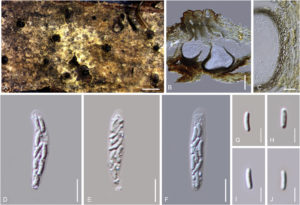Cytospora fraxinigena Senan., Camporesi & K.D. Hyde, sp. nov. MycoBank: MB821568
Etymology: Named after the host genus Fraxinus. Saprobic on dead branch of Fraxinus ornus. Sexual morph: Stromata poorly developed, comprising loosely packed parenchymatous cells, black. Ascomata 350–500 × 150–230 μm (x̅ = 429 × 189 μm, n = 20), immersed in stromatic tissues, globose to subglobose, dark brown, coriaceous, ostiolate, papillate. Papilla 185–200 × 60–95 μm(x̅ = 193 × 79 μm, n = 20), long, central, wide, thick-walled, internally covered by hyaline periphyses. Peridium comprises brown, thick-walled cells of textura angularis. Asci 26–33 × 6.2–7.5 μm (x̅ = 30 × 6.7 μm, n = 20), 8-spored, unitunicate, clavate to fusiform, without apical ring and pedicel. Ascospores 5.5–7.5 × 1.5–2 μm (x̅ = 6.4 × 1.7 μm, n = 20), biseriate, allantoid, hyaline, smooth. Asexual morph: Not observed.
Culture characteristics: Colonies growing on MEA attenuated 1 cm incubated at 18 °C within 7 d, moderate fast growing, irregular, flat, undulate, white, woolly, loosely attached to the media.
Specimen examined: Italy, Province of Forlì-Cesena, Santa Sofia, near Corniolo, dead branch of Fraxinus ornus (Oleaceae), 6 Dec. 2013, E. Camporesi, IT 1562 (holotype MFLU 17–0880, isotype BBH 42442, culture ex-type MFLUCC 14–0868).
Notes: Cytospora fraxinigena forms a distinct clade which is sister to Cytospora cedri and Cytospora rosae (Clade 16). Morphologically, Cytospora fraxinigena differs from those species in having slightly horizontal necks closely arranged at apex and hamathecium without paraphyses.
Fig. Cytospora fraxinigena (MFLU 17–0880). A. Ascomata on substrate. B. Vertical cross section of ascoma. C. Peridium. D–F. Asci. G–J. Ascospores. Scale bars: B = 100 mm, C = 20 mm, D–F = 10 mm, G–J = 5 mm.

